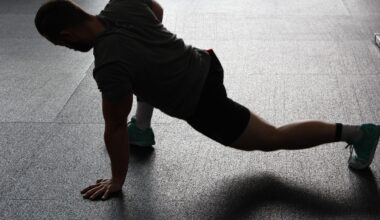Incorporating Technology to Enhance Motivation for Exercise Among Seniors
As our population ages, the importance of maintaining an active lifestyle amongst seniors has become increasingly evident. Exercise can significantly improve physical health, mental well-being, and overall quality of life. However, motivating seniors to engage in regular physical activity may pose unique challenges. Technology offers innovative solutions that can foster motivation, ensuring seniors experience the benefits of exercise. Tools such as wearable fitness trackers, mobile applications, and online communities can stimulate participation, making exercise a more enjoyable endeavor. These technologies can track progress, set achievable goals, and provide feedback, which are essential for maintaining motivation. Furthermore, engaging with others through virtual platforms can create a sense of community, driving seniors to keep moving. Utilizing these tactics encourages seniors to challenge themselves in positive ways, leading to healthier choices and much better outcomes. As we continue to explore different methods to promote the importance of exercise, acknowledging the role of technology becomes essential for effective motivation among seniors. By integrating tech solutions, we can enhance their exercise experience, ensuring they lead a vibrant and active life well into their golden years.
The Role of Wearable Technology
Wearable technology has experienced significant advancements, making it an ideal option for seniors aiming to stay active. Devices like smartwatches and fitness trackers serve dual purposes: they monitor health metrics and encourage regular exercise. These devices can track steps, calories burned, and heart rates, providing immediate feedback to users. With this data, seniors can set personalized fitness goals, tailored to their individual needs. The gamification aspect of wearable devices encourages users to achieve their targets, as they receive notifications and rewards. This feature is particularly beneficial for seniors, who might face health restrictions. Care providers and family members can also access the collected data, offering helpful insights into their health. This promotes accountability while enabling caregivers to design suitable exercise programs based on the senior’s activity level. Moreover, many wearables now come with simple interfaces, making technology user-friendly even for those who are less tech-savvy. Incorporating wearable technology into fitness regimens ensures that seniors receive motivation through real-time data, continuous improvement, and social interaction. Thus, these devices play a critical role in promoting physical activity among older adults, ultimately enhancing their overall well-being.
Mobile applications tailored for fitness and wellness serve as powerful motivators for seniors. Many apps offer tailored workout plans designed specifically for older adults, considering their unique abilities and limitations. These apps provide a platform to track progress, allowing users to see improvements over time. Additionally, some applications offer instructional videos that guide seniors through exercises, ensuring proper form and technique, reducing the risk of injury. Gamified features, like rewards and progress levels, can further spark interest and motivation. By setting personal challenges, seniors boost their confidence as they advance. Moreover, many apps integrate community features, allowing users to connect with friends or family for even greater support. This connection helps foster accountability and encourages healthy competition, which can be motivating factors for continued engagement. Furthermore, reminders and notifications help seniors stay on track with their exercise routines, making it easier for them to establish and maintain healthy habits. As such, fitness-focused mobile applications offer invaluable resources to help seniors remain active and engaged, providing a sense of accomplishment that enhances their overall life satisfaction and wellness.
Online Communities and Social Media
Online communities and social media platforms open new doors for seniors looking to maintain a healthy lifestyle through exercise. These digital spaces foster connections, allowing seniors to interact with others who share similar fitness goals and experiences. Participating in an online community creates a support network where individuals motivate each other to stick to their routines. Engaging with these communities encourages accountability and helps combat feelings of isolation. Additionally, many online platforms host group exercise challenges, which can enhance motivation through friendly competition and shared experiences. These group efforts allow seniors to celebrate their achievements, enhancing their self-esteem and confidence while promoting healthy living. Furthermore, the accessibility of online platforms means that seniors can connect with others at their convenience, tailoring their engagement to fit their lifestyles. By sharing tips, resources, and experiences, seniors benefit from the collective knowledge of a diverse community. This social interaction is crucial, as it fosters camaraderie, making exercise a more appealing and enjoyable activity. Ultimately, leveraging online communities and social media can greatly enhance motivation for seniors, helping them lead active and fulfilling lives.
Integrating virtual reality (VR) technology into exercise routines presents exciting opportunities for seniors to stay physically active. VR offers immersive experiences that can make physical activity feel like an engaging game rather than a chore. By providing visually stunning environments for various workouts, seniors can develop a heightened interest in exercising. Activities such as virtual hiking, dancing, or golfing can transport seniors beyond their physical limitations, promoting not only fitness but also stimulating mental engagement. Additionally, VR can cater to different ability levels, ensuring that everyone can participate and progress at their own pace. The interactive nature of VR encourages seniors to remain focused, enhancing their exercise experience. These sessions can also be conducted in a safe and controlled environment, making it ideal for those who may be hesitant to engage in traditional exercise classes. This technology bridges the gap between fitness and entertainment, allowing seniors to explore new possibilities within the comfort of their homes. Therefore, incorporating VR into exercise programs provides innovative ways to improve motivation, ensuring that seniors stay physically and mentally stimulated.
Setting Realistic Goals
Establishing realistic and achievable goals is crucial when motivating seniors to engage in exercise regimens. Without specific objectives, individuals may feel overwhelmed or uncertain. Using the SMART criteria—specific, measurable, achievable, relevant, and time-bound—can effectively guide seniors in this goal-setting process. By starting with small, manageable targets, seniors can gradually build up their confidence as they accomplish these objectives. When individuals notice progress, it reinforces their motivation and commitment to continued physical activity. Additionally, using technology tools such as fitness apps can greatly assist in tracking these goals, providing visual representations of progress. This visual feedback can help seniors stay engaged and motivated. Moreover, focusing on personal interests and preferences is essential in goal-setting; exercising in a preferred way can make the journey enjoyable. Encouragement from peers, family members, and instructors can further enhance their commitment by offering support and guidance throughout the process. Thus, by fostering an environment of support and understanding while establishing realistic goals, seniors can cultivate a sustainable exercise routine that aligns with their lifestyle and preferences.
Incorporating educational workshops and seminars into senior fitness programs can significantly enhance motivation and understanding. These events create a space for seniors to learn about the physical and mental benefits of regular exercise, ensuring they appreciate the importance of staying active. Knowledgeable instructors or healthcare professionals can share valuable insights on anatomy, nutrition, and effective workout techniques tailored for older adults. Engaging discussions can help seniors feel informed, equipping them with the tools needed to make informed decisions about their health and exercise routines. Additionally, these workshops can encourage an interactive approach, allowing seniors to ask questions about their concerns. By addressing misconceptions and providing accurate information, seniors can develop better confidence in their exercise abilities. Networking opportunities enable them to connect with others on similar health journeys, fostering a sense of community. Ultimately, educational initiatives can empower seniors to take control of their health by actively participating in exercise, promoting both mental and physical well-being. By encouraging lifelong learning, we can inspire seniors to embrace an active lifestyle, enhancing their quality of life through informed choices about fitness.
Finally, integrating regular feedback and progress assessments into exercise programs can further motivate seniors to maintain an active lifestyle. Personalized feedback, whether through wearable devices or app statistics, can help seniors understand their strengths and areas needing improvement. Regular assessments can also track physical improvements, such as increased strength or flexibility, fostering a sense of achievement among seniors. Sharing progress reports with friends, family, or online communities reinforces this positive feedback loop, encouraging them to continue their efforts. By celebrating milestones, even small ones, seniors feel more validated in their commitment to exercise, leading to lasting motivation. Furthermore, establishing a routine for these assessments can help seniors understand the significance of consistency in exercise. Regular check-ins with fitness professionals or peers can ensure participants receive adequate support as they progress. As a result, providing continuous feedback and goal adjustments gives seniors a clearer understanding of their fitness journey, allowing them to adapt their activities as needed. Ultimately, reinforcing achievements cultivates a positive cycle of motivation, inspiring seniors to prioritize their exercise regimens and overall wellness.


